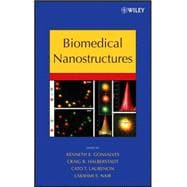
Note: Supplemental materials are not guaranteed with Rental or Used book purchases.
Purchase Benefits
What is included with this book?
Kenneth E. Gonsalves, PhD, is Distinguished Professor in the Department of Chemistry at the University of North Carolina at Charlotte. Dr. Gonsalves has more than fifteen years of experience in using photolithography and chemistry to develop materials that have features at both the micron and nanoscale. Working with Dr. Craig Halberstadt, he has successfully demonstrated the ability to create a new material that can be controlled at both these size scales to influence cell behavior. He has also developed active polymeric nanoparticles for delivery of antibiotics and genes. Craig R. Halberstadt, PhD, is Director of Tissue Engineering and Senior Research Scientist at the Cannon Research Center of Carolinas Medical Center. Dr. Halberstadt is a pioneer in the development of a scalable commercial process for the growth of a human skin product. He has also published extensively on cell/biomaterial interactions for cellular transplantation. Cato T. Laurencin, MD, PhD, is Lillian T. Pratt Distinguished Professor and Chair of the Department of Orthopaedic Surgery and Professor of Biomedical Engineering and Chemical Engineering at the University of Virginia. He has also been designated one of fifteen University Professors at the School. He has authored more than 250 peer-reviewed articles and has edited books in the areas of biomaterials, orthopaedic tissue engineering, and nanotechnology. He is the recipient of several national and international awards and was elected to the National Academy of Sciences, Institutes of Medicine. His current research interests include biomaterial synthesis, orthopaedic tissue engineering, gene therapy, drug delivery, and nanotechnology. Lakshmi S. Nair, MPhil, PhD, is Assistant Professor in the Department of Orthopaedic Surgery at the University of Virginia. She has authored more than fifty peer-reviewed articles in the areas of biomaterials, tissue engineering, drug delivery, and nanotechnology. Her research interests include hydrogels for tissue engineering and drug delivery, stimuli sensitive materials, and biomedical nanotechnology.
| Nanostructure Fabrication | |
| Nanofabrication Techniques | |
| Micro/ Nano-Machining and Fabrication of Materials for Biomedical Applications | |
| Novel Nanostructures as Molecular Nanomotors | |
| Bioconjugation of Soft Nanomaterials | |
| Nanotechnology and Drug Delivery | |
| Polymeric NanoParticles and Nanopore Membranes for Controlled Drug and Gene Delivery | |
| Development of Nanostructures for Drug Delivery Applications | |
| Bioconjugated Nanoparticles for Ultrasensitive Detection of Molecular Biomarkers and Infectious Agents | |
| Bio-Nano Interfaces | |
| ECM Interactions With Cells From The Meso To NanoScale | |
| Cell Behavior Towards Nanostructured Surfaces | |
| Cellular Behavior on Basement Membranes Inspired Topographically Patterned Synthetic Matrices | |
| Focal Adhesions: Self-Assembling Nanoscale Mechanochemical Machines that Control Cell Function | |
| Controlling Cell Behavior via DNA and RNA Transfections | |
| Multi-Scale Co-Culture Models for Orthopaedic Interface Tissue Engineering | |
| Clinical Applications of Nanostructures | |
| Nanostructures for Tissue Engineering/Regenerative Medicine | |
| Nanostructures for Cancer Therapy | |
| Clinical Applications of Micro-and NanoScale Biosensors | |
| Nanoscale Iron Compounds Related to Neurodegenerative Disorders | |
| Application of Nanotechnology into Life Science: Benefit or Risk | |
| Table of Contents provided by Publisher. All Rights Reserved. |
The New copy of this book will include any supplemental materials advertised. Please check the title of the book to determine if it should include any access cards, study guides, lab manuals, CDs, etc.
The Used, Rental and eBook copies of this book are not guaranteed to include any supplemental materials. Typically, only the book itself is included. This is true even if the title states it includes any access cards, study guides, lab manuals, CDs, etc.